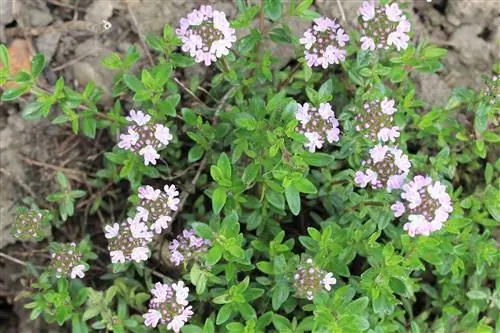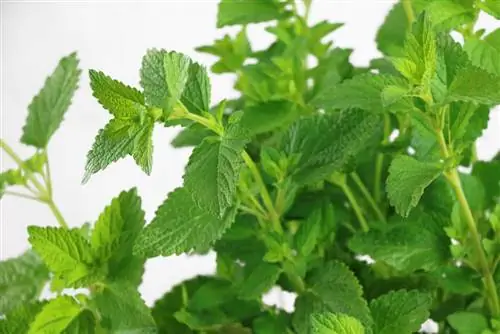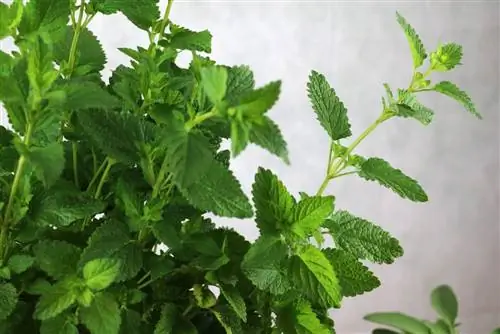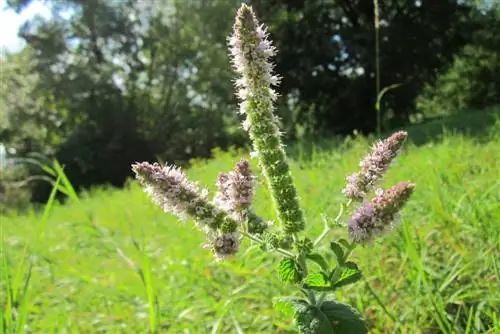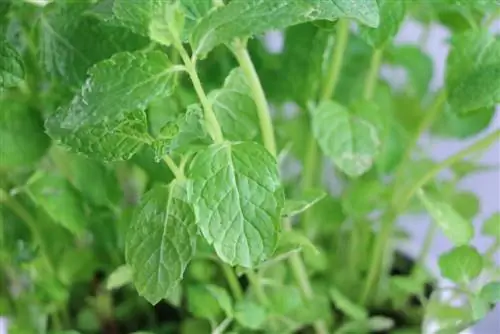- Author admin [email protected].
- Public 2023-12-17 03:39.
- Last modified 2025-06-01 06:48.
The labiate family or mint family is a family of plants that belongs to the order Lamiaceae. There are more than 7,000 different species worldwide that are often used as aromatic plants or ornamental plants in the garden.
Lamiaceae - characteristics and examples
Lamiaceae are a family of plants that can be found either under the Latin name (Lamiaceae or Labiatae. They belong to the order of the Lamiaceae, also called Lamiales in Latin. There are seven subfamilies, 230 genera and over 7.000 species. Mint family plants are found all over the world in all climate zones. There are therefore no general answers for their care. What an individual species from the mint family needs to develop well therefore varies from person to person.
The flowers
The flowers of mint family can be solitary, but can also grow together to form false whorls. In most species they are hermaphroditic, but not fundamentally. There are also dioecious, segregated mint family species. Typical of the appearance of the flowers are five sepals, which are fused into tubes. These include five calyx teeth or two calyx lips. The flowers have an upper lip and a lower lip. The upper lip often also recedes. Usually three of the petals grow together to form the lower lip and two to form the upper lip. In the labiate family, between one and three of the five stamens are reduced, so that later, depending on the species, only four or possibly only two stamens remain. Two of the carpels form an ovary. Many species of the mint family are highly specialized and therefore rely on very specific flower visitors in order to reproduce.
Lamiaceae in the home garden
When selecting mint plants for your home garden, it is advisable to limit yourself to the species that thrive in the relevant region. The choice can be between species that occur in the wild, typical spice plants or pure garden plants, because all of these labiate plants are quite decorative.
Forest edge dwellers among the mint family
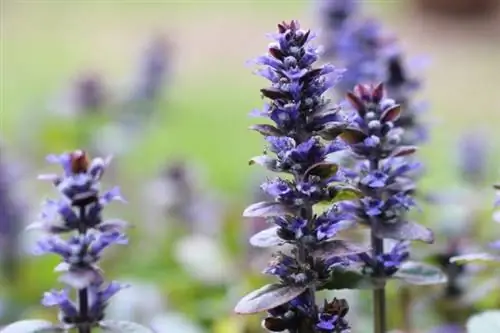
The creeping Günsel and the Gundermann should be mentioned here as examples of forest edge dwellers among the mint family, because both species also offer a decorative image in the home garden. By the way, the crawling Günsel is very loved by bees. It loves sun to partial shade and needs nutrient-rich or acidic soil, but doesn't like waterlogging because it dies quickly there. If the creeping Günsel is to grow as a cushion perennial, it should be planted very densely when planted. The planting distance is around 10 to 20 cm. The plants can be planted in both spring and autumn. It needs enough water to grow. Later, conventional liquid fertilizer is sufficient for care. Lilies of the valley, hostas, primroses or ferns offer a beautiful contrast in the densely growing carpet of the creeping Günsel.
Gundermann also forms dense carpets and is well suited as a flowering ground cover. However, it prefers locations with shade or partial shade and likes heavy, moist and calcareous soils. Gundermann can also be planted in both autumn and spring. Other than enough water to grow, it doesn't need any care later. It harmonizes particularly well with ferns.
Lamiaceae as decorative spice plants
Anyone who uses mint plants as spice plants has a double benefit in the garden. All the typical spice labiatric plants also look very decorative in the perennial garden and thus serve a dual purpose. Some fresh spices are quickly brought in from the garden, but at the same time these spice plants also decorate the flower bed. Lemon balm, sage, thyme and peppermint are examples of mint plants that can serve as a spice plant and flowering perennial at the same time:

- Thelemon balm likes it sunny and protected from the wind. It needs enough water and a soil with plenty of humus, then it comes back year after year and reproduces well. The herb itself is very decorative. When the delicate flowers are added, this perennial becomes even more decorative. As a spice, lemon balm is particularly suitable for fresh salads, sauces and fish.
- AlsoSage needs a sunny and wind-protected place. The soil should be permeable and contain enough lime. Sage needs enough water, but doesn't like waterlogging. Sufficient potassium is important so that the plant becomes and remains frost hardy. It grows quite tall, which should be taken into account when planting the perennials. Sage also grows well in large plant pots and can stand well on the terrace. There are both types of sage that are not suitable as a spice plant and others. If you would like to have sage as a spice in the garden in addition to its decorative appearance, you should pay attention to this. Sage goes very well with roast lamb or fish.
- Thyme needs loose soil and a sunny spot as well as enough protection in winter by piling up, because it is not completely hardy. It is best to sow seeds under glass and then later transplant the young plants outside at a distance of 25 cm from May onwards. Thyme grows to half height and also blooms beautifully. As a spice, it goes well with Italian cuisine, but also with stews and pork.
- The realpeppermint is particularly popular for making tea. But it also looks very decorative. When planting, care should be taken to create a separate bed for the peppermint or to place it in a large pot on the terrace, as it spreads very quickly and can overgrow other plants. It is quite undemanding when it comes to soil, but needs enough water and should be protected from frost.
Lamiaceae as pure garden perennials
Coleus and lavender are examples of mint plants that are planted in the garden purely for decorative purposes.
Coleus nettles have a decorative effect simply because of their beautiful foliage, even when they are not in bloom. It is important to note that coleus is not hardy. But they can overwinter well in the greenhouse. In summer, the cuttings, which are always taken from the mother plant and placed in pots to form roots, can be planted outdoors. Coleus needs a lot of sun, a place protected from the wind, enough compost and well-drained soil to develop well. If the irrigation water is occasionally enriched with a conventional liquid fertilizer, this is sufficient for care.
Lavender is hardy and harmonizes beautifully with roses of different colors because it offers a nice contrast. Gypsophila also looks very pretty on a lavender bed. The scent of lavender is unmistakable. The bees, bumblebees and butterflies love lavender and will find it in large numbers. The plant loves sun and calcareous soil. It is important to know that the perennials must not be cut back too much, as they will often die. It is enough just to slightly shorten the dead inflorescences.
What you should know about the mint family in brief
Selected species
The individual subfamilies in turn include different species and genera. These include, for example, Lamiodeae Harley with around 63 genera and 1,210 plant species. This subfamily primarily includes unflavored, smaller trees or shrubs. The Nepetoideae Kostel, with its more than 3,600 species and around 130 genera, belong to another subfamily, which includes sage alone with over 900 species. This is followed by five other subfamilies, such as Ajugoideae Kostel, Scutellarioiseae Caruel, Prostantheroideae Luerss, Symphorematoideae Briq and Viticoideae Briq.
Well-known mint family
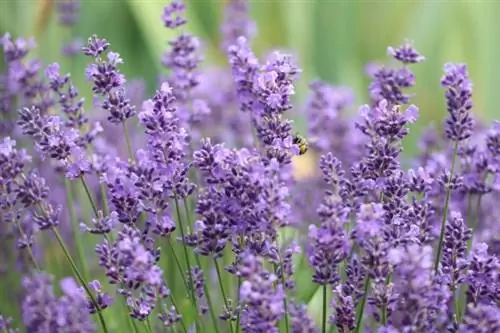
- Lavender: This species is primarily found in Italy and Greece. The plant itself grows to a height of around 30 to 60 cm and is used in the cosmetics industry or in natural medicine.
- Thyme: This species, which is around 30 cm high, is particularly widespread in Asia and Africa and is used, for example, for tea.
- Basil: This grows up to 60 cm high and is often used as a seasoning. This species originally comes from India and is now widespread.
Features
- Most plants of over 7,000 species contain essential oils, such as rosemary, basil or lavender.
- The herbaceous plants are mainly found in warm and sunny places.
- They have square stems, two fused petals on the upper lip and three fused petals on the lower lip.
Usage
Due to their aromatic effects, most mint plants are used as spice plants. At least two types - Japanese patchouli and Indian patchouli - are used as a raw material for perfume production. Otherwise, because of their appearance, mint plants are also often cultivated as ornamental plants and decorate roadsides, meadows or gardens.
Conclusion
Most mint plants are hardy perennials, but not all. Each species needs its own individual care because not all mint plants have the same requirements. You should therefore always find out about the requirements of a particular species before planting mint family.

